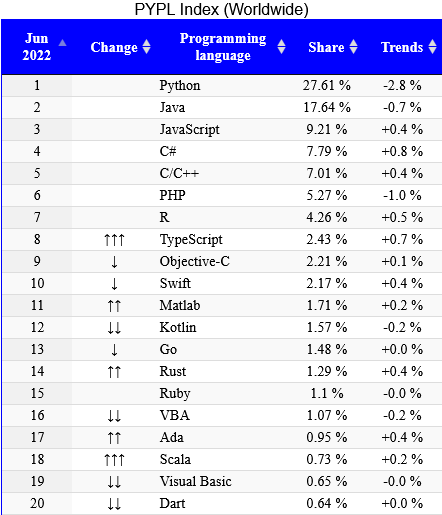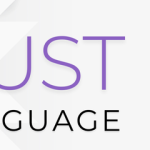Before learning or selecting any programming language, we must be aware of the popularity of the programming language, its advantages, disadvantages, its growth potential, and the opportunities it offers. We, with the valid facts below, show which language is progressing and which language is losing. As per recent stats, Python seems to progress very fast and has already captured Position 1 surpassing Java.
We are here going to compare programming languages as per different programming languages index and rankings.
As per Tiobe Index, Java is on the losing side. Java was number 1 a few months back. Python is now number 1, as per June 2022 index. [TIOBE Index is a measure of the popularity of programming languages, created and maintained by the TIOBE Company based in Eindhoven, the Netherlands].

As per PYPL, Python is again ranked as the number 1 programming language worldwide. The PYPL PopularitY of Programming Language Index is created by analyzing how often language tutorials are searched on Google.


As per GitHub language stats, Python is again ranked as number 1 in 2022. Github is the largest code repository in the world and it monitors its repository and publishes its popularity based on updates and additions and commits that happened for a language.

Based on the above stats and reports, we can conclude that Python is the number 1 programming language in popularity. We can select the below top languages to learn so that it gives you good exposure and growth Opportunities.
Python: Python is a language that has been consistently growing in popularity and is widely used for data science, machine learning, and web development. Its ease of use and powerful libraries have made it a popular choice among developers. Another reason for the popularity of Python is its versatility. Python can be used in a wide range of applications, from web development and data science to scientific computing, artificial intelligence, and machine learning. You can learn python using this python roadmap link, if interested.
Java: Java is one of the most widely used programming languages, with a large community of developers and a vast ecosystem of tools and libraries. As such, it is expected to remain relevant and in demand in the future.
C/C++: C and C++ have been widely used programming languages for several decades and are still widely used today. While newer programming languages have emerged, C and C++ remain popular and are expected to remain relevant in the future
Javascript: JavaScript is another language that is widely used for web development and is expected to remain popular in the future. With the increasing demand for web applications and the growth of the internet of things (IoT), JavaScript is likely to remain in high demand.
GO: Go, also known as Golang, is a relatively new programming language that was developed by Google in 2009. Since its release, Go has gained popularity and is now widely used for developing web applications, network tools, and distributed systems. Another advantage of Go is its built-in support for concurrency.
RUST: Rust is a relatively new programming language that was first released in 2010. One of the main advantages of Rust is its focus on safety and performance. Rust is designed to prevent common programming errors like null pointer de-references and buffer overflows, which can cause security vulnerabilities and crashes. This focus on safety makes Rust well-suited for developing systems that require high reliability and security, such as operating systems, browsers, and network servers. You can learn RUST using this rust roadmap link, if interested.
The codes (if any) mentioned in this post can be downloaded from github.com. Share the post with someone you think can benefit from the information





